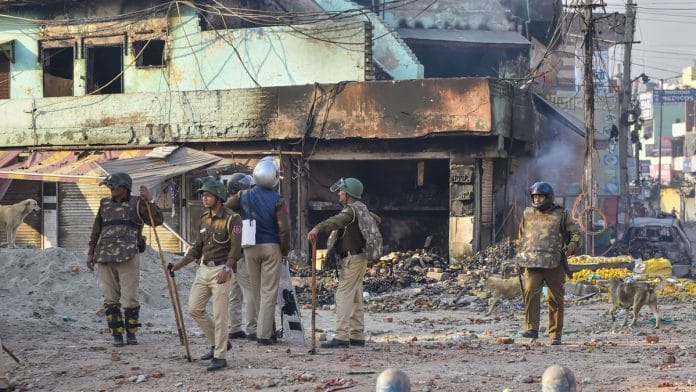New Delhi: Interesting patterns arise when the Delhi riots this week are seen from the perspective of data and history — of both the national capital and the country.
The Delhi perspective
According to data compiled by political scientists Ashutosh Varshney and Steven Wilkinson, between 1950 and 1995, 93 lives had been lost in Hindu-Muslim communal riots in Delhi. This included the riots of 1974 in Sadar Bazar, which killed 10, the riots in Hauz Khas in which 15 were killed, as well as the riots in Seelampur, in which about 30 were killed.
In this period, other cities — Bombay (now Mumbai), Baroda (now Vadodara), Hyderabad, Calcutta (now Kolkata) — had all seen much bigger riots, and Delhi stood as an exception.
The 1984 violence killed Sikhs, and was not a riot but a straightforward pogrom.
Between 1995 and 2020, there is no reference of lives having been lost in a Hindu-Muslim riot.
Now, two things have happened: In just one set of riots over 36 hours, Delhi has lost at least 38 lives in Hindu-Muslim riots. Second, on all evidence, this makes it the biggest communal riot in Delhi in terms of lives lost.
As India gets bets better connected with more media and communication, casualty numbers in riots are coming down. For example, in the Trilokpuri riots of 2015, nobody was actually killed.
Also read: Why Northeast Delhi violence is India’s first Hindu-Muslim riots with guns
The national perspective
The 1980s were fraught with riots. In the Nellie massacre of 1983, about 3,000 lives were lost. The next year, the anti-Sikh riots in Delhi and Kanpur put the toll at another 3,000. BJP leader L.K. Advani also began his Rath Yatra which sparked more riots.
In 1992, a number of riots were set off after the Babri Masjid’s demolition, killing thousands of people in several states. It was the last pan-national or pan-state Hindu-Muslim riot in the country. In the 28 years since it was demolished, India has not seen a pan-series of communal riots.
Ten years later, Gujarat saw the 2002 riots, in which a little over 1,000 were killed, mostly Muslims. These riots, however, were confined to this state.
The next sizeable riot took place in Muzaffarnagar, Uttar Pradesh, 11 years later, wherein about 46 people were killed. It was seen as a big riot because for the previous 12-13 years, India had not seen riots. These riots too, were confined to one district in western UP even though neighbouring districts shared the same demographics.
India’s tolerance for communal riots has been coming down as our economy grows and society evolves.
Also read: ‘BJP being singled out’ — Manoj Tiwari wants independent body that will define hate speech
Things to note
What these numbers reveal is that the gap between two successive riots has been increasing; the number of dead in these riots has been falling drastically; the geographical spread of riots is becoming more contained; and our popular acceptance and tolerance for communal riots is going down.
Delhi’s riots happen at a time when these factors are into play. On the one hand, they were contained and didn’t spread beyond northeast Delhi or into UP. There has been an immediate revulsion and protests against these riots, revealing the low tolerance of such incidents.
On the other hand, they buck the national trend of a greater gap between riots, fewer casualties, and the slowing spread of riots. They also buck the Delhi trend of not having big Hindu-Muslim communal riots.
You can watch the full episode here.
Also read: ISIS now using viral image of Muslim man beaten up in Delhi riots to call for ‘retaliation’







It is no longer a doubt that a screw is loose with Indians and two of them are loose in the brain of the north Indians.
What various untilegent agencies are doing?
Why police did not took any action in Delhi? Who instigated riots is second thing but why in advance or in the same moment police or give did not took any actions? Now from mere fingerprints you know the name and address of culprit. Due to Adahar Card.
If central gov can not take any action and under their nose riots happened what do we aexpect from givernment
ThePrint’s journalists and authors must be rejoicing in their hearts as what they wanted has ultimately happened in Delhi.